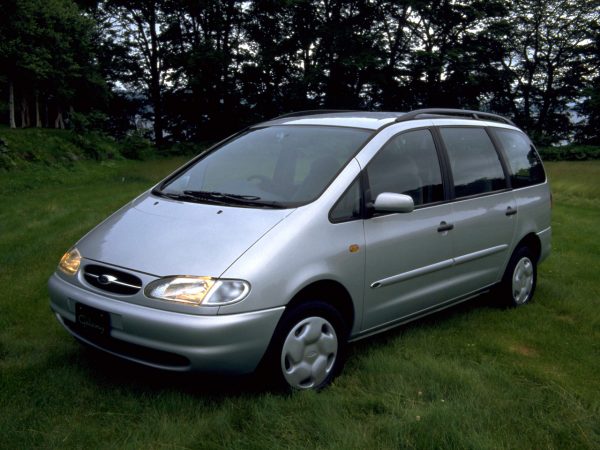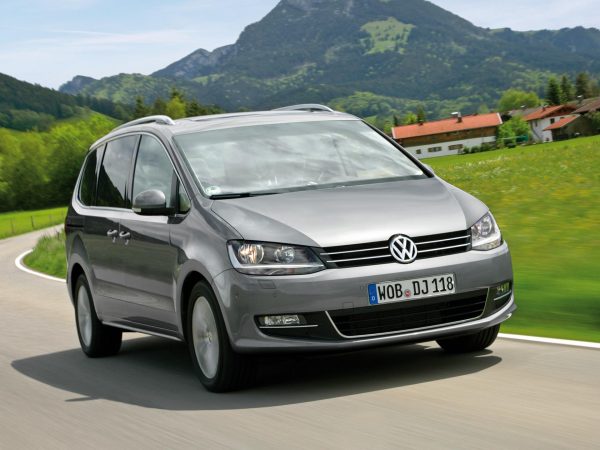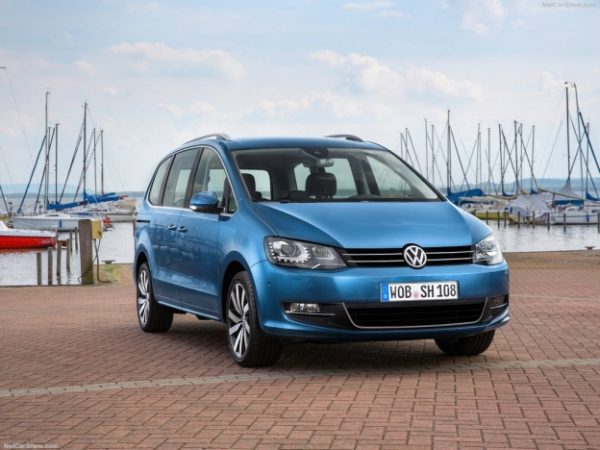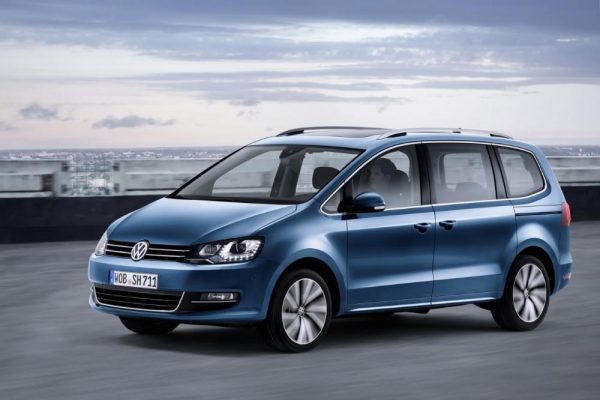
Volkswagen Sharan - a minivan for kings
Content
Volkswagen Sharan is a rare guest on Russian roads. The reason for this is partly that the model was not officially supplied to the Russian market. Another reason is that this product is niche. Sharan belongs to the class of minivans, which means that the main consumer of this car is large families. Nevertheless, the demand for cars of this class is growing every year.
Volkswagen Sharan Review
The emergence of minivans as a class of vehicles took place in the mid-1980s. The ancestor of this type of car is the French car Renault Espace. The market success of this model has prompted other automakers to look into this segment as well. Volkswagen also turned its eyes to the minivan market.

How the Volkswagen Sharan was created
The development of the minivan Volkswagen began together with the American Ford. By that time, both manufacturers already had experience in creating high-capacity vehicles. But these cars belonged to the class of minibuses. Now, the American and German designers were faced with the task of creating a seven-seat family car that would be close to a passenger car in terms of comfort and handling. The result of the joint work of manufacturers was a car reminiscent of the layout of the French minivan Renault Espace.
Production of the model began in 1995 at the Autoeuropa car factory in Portugal. The car was produced under two brands. The German minivan was named Sharan, which means "carrying kings" in Persian, the American one became known as Galaxy - Galaxy.

Ford Galaxy had minor differences from its counterpart in terms of appearance and interior, and a slightly different set of engines. In addition, since 1996, the production of the third twin under the Spanish brand Seat Alhambra began at the same automobile plant. Its resemblance to the base model was broken only by another emblem on the body.

Production of the first generation Sharan continued until 2010. During this time, the model has undergone two facelifts, there have been minor changes in the geometry of the body, and the range of installed engines has expanded. In 2006, Ford moved production of the Galaxy to a new car plant in Belgium, and since then the development of the American minivan has gone without the participation of Volkswagen.
Until 2010, about 250 thousand copies of the Volkswagen Sharan were produced. The model received wide recognition from the European public, which was evidenced by the prestigious automotive awards in the nomination "Best Minivan".
By 2010, Volkswagen had developed the next generation of the Sharan. The new model was created on the Passat platform and has a new body. The new model has become more powerful, and larger, and, frankly, more beautiful. There have been many technical improvements. In 2016, the minivan was restyled and perhaps this signals the imminent release of the third generation Sharan. Moreover, since 2015, its closest competitor in the minivan class, Galaxy, has been produced in the third generation.

The lineup
Sharans of both generations have a classic one-volume layout for minivans. This means that in one body, both the passenger compartment and the compartments for the engine and luggage are combined. Salon assumes 7- and 5-seater performance. A notable innovation in the layout was the sliding doors of the second row.
In the first editions, the car was supplied in 5 engine trim levels:
- 2-liter with a capacity of 114 liters. With. - gasoline;
- 1,8-liter with a capacity of 150 liters. With. - gasoline;
- 2,8-liter with a capacity of 174 liters. With. - gasoline;
- 1,9-liter with a capacity of 89 liters. With. - diesel;
- 1,9-liter with a capacity of 109 liters. with. - diesel.
All modifications of the car were front-wheel drive, and only the modification with the most powerful engine was equipped with an all-wheel drive transmission at the request of the customer.
Over time, the range of engines has expanded with three new diesel engines and one engine that runs on both gasoline and liquefied gas. Engine power with a volume of 2,8 liters increased to 204 liters. With.
The first Volkswagen Sharan has the following weight and size characteristics:
- weight - from 1640 to 1720 kg;
- average load capacity - about 750 kg;
- length - 4620 mm, after facelift - 4732;
- width - 1810 mm;
- height - 1762, after facelift - 1759.
On the second generation Sharan, the average engine power increased. There is no longer an 89-horsepower engine in the trim levels. The weakest engine starts with a power of 140 hp. With. And the most powerful gasoline engine of the new TSI series remained approximately at the same level of 200 hp. with., but due to a qualitative improvement allowed to reach speeds of up to 220 km / h. Sharan of the first generation cannot boast of such speed characteristics. Its maximum speed with a 2,8 liter engine is 204 hp. With. barely reaches 200 km per hour.
Despite the increased power, the second generation engines have become more economical and environmentally friendly. The average fuel consumption for a diesel engine was about 5,5 liters per 100 km, and for a gasoline engine - 7,8. Emissions of carbon monoxide into the atmosphere have also been reduced.
Volkswagen Sharan of the second generation has the following weight and size characteristics:
- weight - from 1723 to 1794 kg;
- average load capacity - about 565 kg;
- length - 4854 mm;
- width - 1905 mm;
- height - 1720.
Sharans of both generations have manual and automatic transmissions. Automation on the first generation is implemented using Tiptronic technology, patented in the 90s by Porsche. The second-generation Sharan is equipped with a DSG gearbox - a dual-clutch robotic gearbox.
Sharan 2017
In 2015, at the Geneva Motor Show, Volkswagen introduced the next version of the Sharan, which will be sold in 2016-2017. At first glance, the car has not changed much. A connoisseur of the brand will surely notice the LED contours of the running lights on the headlights and the redesigned taillights. The filling of the car and the range of engines have undergone much more changes.

Specification Changes
One of the main announced changes in the new model was efficiency and environmental friendliness. Engine characteristics have been changed to Euro-6 requirements. And fuel consumption, according to manufacturers, has become 10 percent less. At the same time, a number of engines have changed power:
- 2-litre TSI petrol engine with 200 hp With. up to 220;
- 2-liter TDI diesel engine - from 140 to 150;
- 2-liter TDI diesel engine - from 170 to 184.
In addition, a diesel engine with a capacity of 115 liters appeared among the power units. With.
The changes also affected the wheels. Now the new Sharan can be fitted with three wheel sizes: R16, R17, R18. Otherwise, the chassis and engine-transmission parts have not changed, which cannot be said about the interior and additional equipment of the car.
Changes in trim levels
A modern car tends to change more on the inside than on the outside, and the Volkswagen Sharan is no exception. Interior designers and electronics specialists have worked hard to make the minivan even more convenient and comfortable for the driver and passengers.
Perhaps the most exotic innovation in the interior of the car is the massage function of the front seats. This option will certainly be useful to those who are forced to be behind the wheel for a long time. By the way, the steering wheel is made in the style of sports cars - the lower part of the rim is made straight.
Among the changes in electronic driver assistants, it is worth noting:
- adaptive cruise control;
- frontal proximity control system;
- adaptive light system;
- parking assistant;
- marking line control system.
Advantages and disadvantages of petrol and diesel models
Gasoline or diesel? — The main question asked by future Sharan owners when choosing a car. If we take into account the environmental factor, then the answer is obvious. The diesel engine is less harmful to the environment.
But this argument is not always a convincing argument for the car owner. The main reason for choosing a diesel version of the car is the lower fuel consumption compared to gasoline. However, the following factors should be taken into account:
- a diesel engine is more expensive to maintain - there are difficulties in finding qualified specialists;
- cold Russian winters sometimes lead to problems with starting the engine in severe frosts;
- diesel fuel at filling stations is not always of high quality.
Taking into account these factors, owners of diesel Sharans should pay special attention to engine maintenance. Only with this approach, the use of a diesel engine will bring real benefits.

Prices, owner reviews
Volkswagen Sharan of all generations enjoys the traditional love of its owners. This is due to the fact that such cars are purchased by people who clearly understand what they want to get from this car. As a rule, the owners have cars of the late 90s - early 2000s in their hands. There are few Sharans of the latest models in Russia. The reason for this is the lack of an official supply channel and a rather high price - the cost of a car in the basic configuration starts from 30 euros.
Prices for used cars start at 250 thousand rubles and depend on the year of manufacture and technical condition. When choosing a Sharan with mileage, you should pay special attention to the reviews of the owners. This is valuable information that can be used to draw conclusions about the features of the car.
The car is not for Russia. August 27, 2014, 22:42 The car is excellent, but not for our roads and our fuel. It was the second Sharan and the last, I will not step on this rake again. The first machine was from Germany in 2001, it even worked differently. After a month of operation in the central region, a tractor engine noise appeared, a characteristic smell of a solarium, and away we go: the suspension died in two months, the repair cost about 30000 rubles; the fuel system began to go crazy after the first frost. The vaunted economy of diesel cars has been blown to smithereens. Engine oil change every 8000 km, fuel and air filter change every 16000 km, i.e. through time. After such maintenance, the costs, only for maintenance, blocked all the savings on diesel fuel. By the way, the consumption on the highway is 7,5 liters per 100-nu. In the city, in winter with heating and automatic heater 15-16l. Without a heater in the cabin a little warmer than outside. But he, the dog, attracts with his comfort of travel and the convenience of the cabin. The only car in which after 2000 km, without stopping, my back did not hurt. Yes, and the body looks solid, I still look back at the balls. Second Sharan 2005 I was killed in general, hitting 200000 wooden ones. The previous owner, apparently, added high-quality additives during the sale and the car honestly drove 10000 km without problems and that’s it: nozzles (each for 6000 rubles), compression (replacing rings - 25000), brake vacuum (hemorrhoid thing, new 35000, used 15000), conder (the front pipe always leaks, even a new one needs to be soldered - illness, repair with disassembly of the entire front part - 10000 rubles), heater (repair 30000, new - 80000), fuel heating nozzles, turbine replacement (new 40000 rubles, repair - 15000) and so little things! The price tags are average, plus or minus 1000 rubles, I don’t remember even a penny, but I had to take a loan! So, think a hundred times whether you need to invest so much money in comfort. Maybe there are no such problems with gasoline, I don’t know, I haven’t tried it, but there is absolutely no desire either. Bottom line: a beautiful, convenient, comfortable car with expensive and constant maintenance. Not for nothing they are not officially delivered to Russia!
Sharan minivan? Railway carriage!
Inert car, due to its weight. A frisky car, thanks to its power unit (a diesel engine pulls 130 horses). The mechanic's box is also suitable, although not for everyone. Salon is too big, even strange. When a VAZ 2110 stands nearby, the width is the same. Shumka Pts good, despite the years (15 years). The bottom is perfectly processed, the body does not bloom anywhere. The Germans made the chassis under Russian roads, their experience of moving across Russia into World War II affected, well done, they remember. Only the front struts are weak (they would be one and a half times larger in diameter). About the electrician "nain" to say "bad" electrician is buzzing. I am engaged in the repair and restoration of foreign cars, so there is something to compare. For example, there is a complete mess in the behahs, the wires are not laid, but thrown by an unlaid “oblique”. The conductors are not tied, not packed in plastic troughs. The Bavarians had to produce beer and sausages, they are good at it, and cars (BMW) are just a popular brand. There were 5 and 3 ,, nineties ,,. Then come MB, in terms of quality and reliability, here the Stuttgart guys have good diesel engines due to in-line high-pressure fuel pumps and a double timing chain. And they don’t have crankshaft seals, rear ones, byada.a.a ...., like on GAZ 24, they just have a braided pigtail instead of a gland and it constantly flows. Then come Audi and Volkswagen, I'm talking about the quality, of course the German assembly, and not Turkish or even more so Russian. There were MB and Audi. I noticed that the quality is deteriorating every year, especially after reystaling. As if they are specifically doing it so that spare parts are bought more often (or maybe it is?). On my "sharan" there is an electronic injection pump, the engine is noisy, people call such cars "TRACTOR". But it is more reliable than the injector pump and ... cheaper. As for comfort in a minivan: cool and comfortable and visible, except for the front window pillars of course, but you have to be more careful and you can get used to it. I do not need parking sensors, you can rent without it. The air conditioner cools, the stove heats up, but only after Eberspeicher is turned on (an additional antifreeze heater is located under the bottom near the rear left door. Who will have questions, my skype is mabus66661 Good luck to all of us.
Machine for life
I bought a car 3,5 years ago, of course, it’s not a new one. Mileage under my control is 80t.km. Now the mileage on the car is 150, but this is on a computer, no one knows what in life. For 000 winters in Moscow, never. Never had any problems starting the car. The fact that people write about the inability of diesel cars to our conditions is nonsense. People, change the battery when buying, fill in normal diesel fuel, add anti-gel in wild frosts and that's it. The machine will thank you with the rhythmic operation of the motor. Well, it's a lyric. Now the specifics: during the operation I changed: -GRM with all the rollers and pomp - silent blocks - 3-3 times - the racks are all in a circle (almost immediately after purchase) - I replaced the 4 discs with a radius of 17 and put high tires. - CV joints - one side 16 times, the other 2. - a pair of tips. — Engine pillow — Battery — the first wintering in Moscow (German died). OK it's all over Now. With a very frisky ride in Moscow, the car eats 1-10 liters in the city. With air conditioning on the highway - 11l at a speed of 8-130. A mechanical 140-mortar works in such a way that at the start people are surprised by the agility of this machine. Salon - it's useless to tell - go into it and live. With a height of 6 cm, I feel great, and the most interesting thing is that the passenger sitting behind me, too! Find at least one other car where this is possible. Front and rear parking sensors are amazing! On the trade wind, people were afraid to park in the yard, and SHARAN got up (thanks to parking sensors) easily! I have a weakness for long trips and there has never been such a thing that the slightest pain in my back or in the fifth point has appeared. Of the minuses - yes, the interior is large and warms up in winter for 190 minutes, cooling in summer is also about 10-10 minutes. Although there are air ducts from the windshield right up to the back door. - Hans could still make the back door on the electric drive, and so they make their hands dirty. Trunk - at least load an elephant. Load capacity - 15k
Tuning Sharan
It would seem that the manufacturer has provided for all the little things in the car, but there is still room for improving the car. Tuning parts suppliers offer a wide range of improvements for those who like to decorate their minivan:
- power thresholds;
- kenguryatnik;
- lighting solutions for the salon;
- headlight covers;
- roof spoiler;
- decorative body kits;
- deflectors on the hood;
- window deflectors;
- Seat Covers.
For everyday use of a minivan on country roads, it will be useful to install a deflector on the hood. The design feature of the Sharan is that the hood has a strong slope, and when driving at high speed, it strives to collect a lot of dirt from the road. The deflector helps deflect the flow of debris and keep the hood from chipping.
A useful element of tuning for Sharan will be the installation of an additional luggage system on the roof of the car. As practice shows, minivans are often used for long-distance travel, and if all seven seats are occupied by passengers, then 300 liters of a standard trunk is not enough to accommodate all things. Installing a special box on the roof will allow you to additionally place luggage weighing up to 50 kg and up to 500 liters in volume.

There is a common semi-joking opinion among experienced car owners that the best car is a new car. This would fully apply to the Volkswagen Sharan if the car was officially supplied to the Russian market. In the meantime, the Russian consumer has to be content with Sharans, as they say, not the first freshness. But even owning these minivans from the late 90s works positively for the reputation of this brand and over time will create a solid customer base of Sharan fans.

